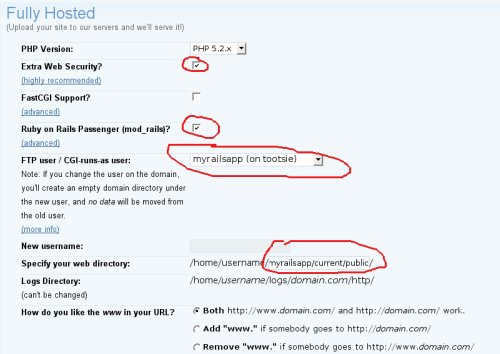Introduction
I could not find an updated documentation on how to setup properly a rails application on Dreamhost, so I thought I’d share the information I gathered.. First off, thanks to the Phusion team, with Passenger (a.k.a. mod_rails), it’s now very convenient, easy, and cheap to run a rails application on Dreamhost.
Also, special thanks to Todd Huss for discovering the multi dreamhost user hack. Basically, you need to run each of your rails application on Dreamhost under a different shell user. Their process monitor, will start killing your processes when the total memory per user exceeds 200 MB of virtual memory (VSZ).
So here’s the guide, even perfect newbees and skript-kiddies should be able to follow :
The complete step by step
INFO : Let Capistrano create the directory structure on the server BEFORE you set the public dir of your application in the edit domain section of the Control Panel. This will avoid you conflicts when Capistrano attemps to create the symlinks.
First, configure your new rails application using Dreamhost Control Panel :
- Create a new repository for your application (screenshot)
- Create a new shell / SSH user (read why here) with the same name as your application (screenshot)
- Create a new database (screenshot)
Add your application to your repository
Create your rails skeleton (if it’s done yet), on your local machine (assuming you use *nix, but should be similar on Windows)
rails myrailsapp --freezeAdd your application to the repository
$ cd myrailsapp $ svn mkdir http://svn.myrailsappdomain/myrails/trunk $ svn checkout http://svn.myrailsappdomain/myrails/trunk ./ $ svn add * $ svn commitExclude database configuration, temporary files, and any user upload directory from the source control :
$ svn copy config/database.yml config/database.yml.example $ svn remove config/database.yml -f $ svn propset svn:ignore "database.yml" config/ $ svn remove tmp/* $ svn propset svn:ignore "*" tmp/ # If you need to share unversionned user-uploaded files, between deploys : $ mkdir public/uploads $ svn add public/uploads $ svn propset svn:ignore "*" public/uploads/ $ svn remove log/* $ svn propset svn:ignore "*" log/ $ svn remove db/*.sqlite3 $ svn propset svn:ignore "*.sqlite3" db/ $ svn commit
Next, create the Capistrano recipe :
Create recipe skeleton :
$ cd /path/to/your/myrailsapp $ capify . [add] writing `./Capfile' [add] writing `./config/deploy.rb' [done] capified!Replace the content of
config/deploy.rbwith the following :############################################################# ## General ############################################################# set :application, "myrailsapp" ############################################################# ## Servers ############################################################# set :use_sudo, false # Dreamhost does not support sudo set :user, application # Dreamhost SSH User set :domain, "myrailsapp.domain.com" server domain, :app, :web role :db, domain, :primary => true ############################################################# ## Subversion ############################################################# set :scm, :subversion set :scm_user, application # Sets 'my_svn_user' instead, if you are using different name than your app. set :scm_auth_cache, true # Prompts for password once set :scm_password, Proc.new { Capistrano::CLI.password_prompt("SCM password for #{scm_user}:") } set :repository, "http://svn.myrailsappdomain/#{application}/trunk" set :deploy_to, "/home/#{user}/#{domain}" # keeps a local checkout of the repository on the server to get faster deployments set :deploy_via, :remote_cache ############################################################# ## Tasks ############################################################# namespace :deploy do desc "Restart Application (using tmp/restart.txt)" task :restart_passenger do run "touch #{current_path}/tmp/restart.txt" end desc "Restarts your application." task :restart do restart_passenger end desc "Link shared files" before :symlink do run "rm -drf #{release_path}/public/uploads" run "ln -s #{shared_path}/uploads #{release_path}/public/uploads" run "rm -f #{release_path}/config/database.yml" run "ln -s #{shared_path}/database.yml #{release_path}/config/database.yml" end end
Then, prepare the directory structure on the server :
Create the Capistrano structure (releases/, shared/), by typing this on your local machine :
$ cap deploy:setupLogin to your server to manually create your shared directories and files (if any)
$ ssh myrailsapp.domain.com [tootsie]$ cd myrailsapp/sharedConfigure your database on the server (you don’t want this file in your repository) :
# config/database.yml development: adapter: sqlite3 database: db/development.sqlite3 timeout: 5000 test: adapter: sqlite3 database: db/test.sqlite3 timeout: 5000 production: adapter: mysql encoding: utf8 database: myrailsapp username: myrailsapp password: [your_db_password] host: mysql.[myrailsapp.domain].com timeout: 5000Create your upload directory (OPTIONAL) :
[tootsie]$ mkdir uploads
Deploy your application. Note : it will only prompt for your SVN password at the first deploy.
$ cap deployAnd finally the most important, configure your domain like this :

[UPDATE 2008/07/01]
If you need to install custom gems on your account, you can find more info here, here and here.
References
- http://labs.peritor.com/webistrano/wiki/ConfigurationParameter
- http://groups.google.ca/group/capistrano/browse_thread/thread/6ef7c7c212547eab (for scm_password)
- http://groups.google.com/group/capistrano/browse_thread/thread/ae7b16a16abf4e5d (for task hookups with namespaces)
- http://groups.google.com/group/capistrano/web/deploying-on-dreamhost
- http://gabrito.com/post/ruby-on-rails-dreamhost-plugin
- http://www.railsforum.com/viewtopic.php?id=8118
- Dreamhost Wiki : Capistrano
- Dreamhost Wiki : Ruby on Rails
- Capistrano Manual